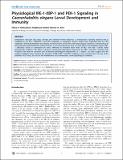Physiological IRE-1-XBP-1 and PEK-1 Signaling in Caenorhabditis elegans Larval Development and Immunity
Author(s)
Kim, Dennis H.; Richardson, Claire Elissa; Kinkel, Stephanie
DownloadRichardson-2011-Physiological IRE-1-.pdf (522.0Kb)
PUBLISHER_CC
Publisher with Creative Commons License
Creative Commons Attribution
Terms of use
Metadata
Show full item recordAbstract
Endoplasmic reticulum (ER) stress activates the Unfolded Protein Response, a compensatory signaling response that is mediated by the IRE-1, PERK/PEK-1, and ATF-6 pathways in metazoans. Genetic studies have implicated roles for UPR signaling in animal development and disease, but the function of the UPR under physiological conditions, in the absence of chemical agents administered to induce ER stress, is not well understood. Here, we show that in Caenorhabditis elegans XBP-1 deficiency results in constitutive ER stress, reflected by increased basal levels of IRE-1 and PEK-1 activity under physiological conditions. We define a dynamic, temperature-dependent requirement for XBP-1 and PEK-1 activities that increases with immune activation and at elevated physiological temperatures in C. elegans. Our data suggest that the negative feedback loops involving the activation of IRE-1-XBP-1 and PEK-1 pathways serve essential roles, not only at the extremes of ER stress, but also in the maintenance of ER homeostasis under physiological conditions.
Date issued
2011-11Department
Massachusetts Institute of Technology. Department of BiologyJournal
PLoS Genetics
Publisher
Public Library of Science
Citation
Richardson, Claire E., Stephanie Kinkel, and Dennis H. Kim. “Physiological IRE-1-XBP-1 and PEK-1 Signaling in Caenorhabditis Elegans Larval Development and Immunity.” Ed. Kaveh Ashrafi. PLoS Genetics 7.11 (2011): e1002391. Web. 23 Feb. 2012.
Version: Final published version
ISSN
1553-7390
1553-7404